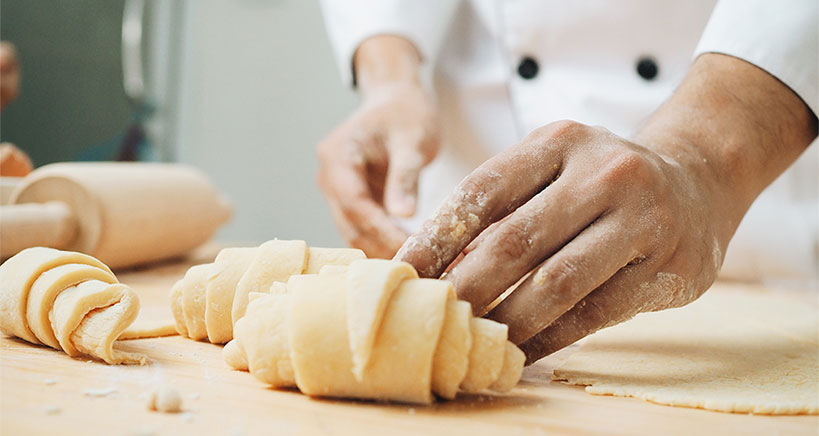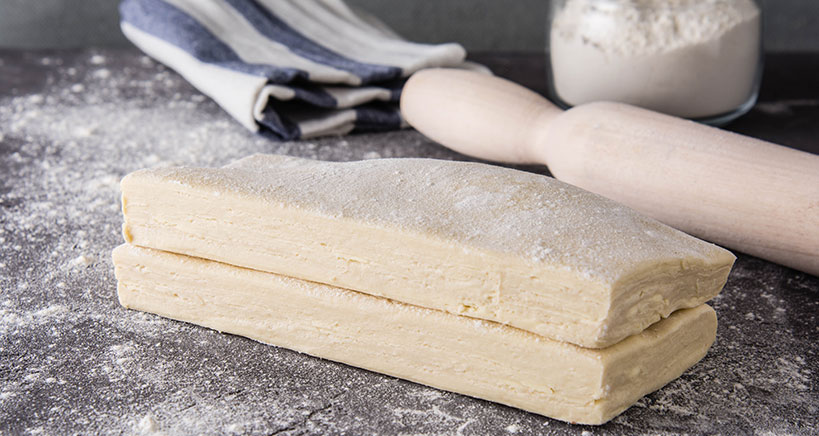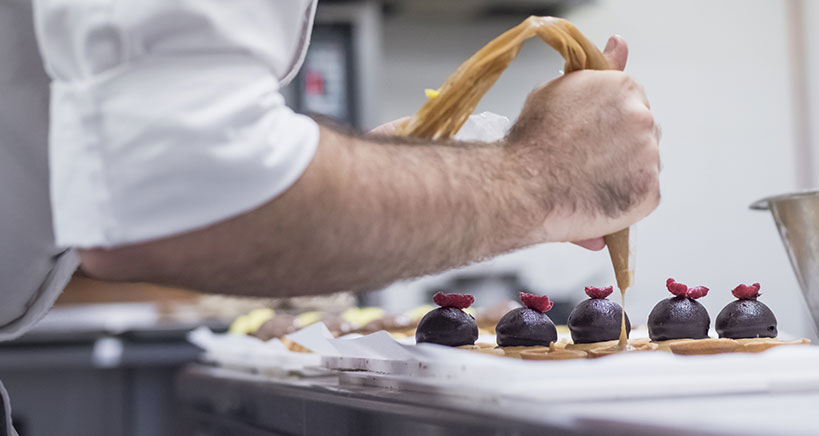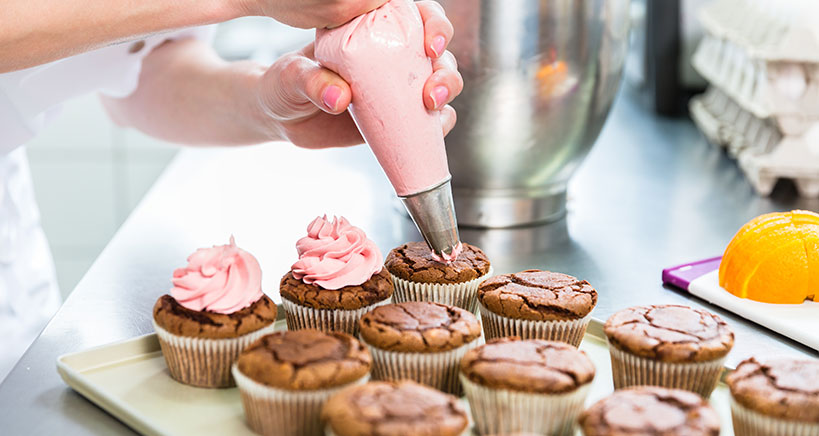How French Cuisine Has Permeated More Than Our Palates
If the perfect pastry is what your customers are craving, you have come to the right place! In fact, if you work anywhere in foodservice, and especially if you own a bakery, patisserie, or café, the following guide on how to make the perfect pastry is your recipe for success.
At their essence, all pastries are doughs made from fat (usually butter), flour, and water (with the occasional egg). Remarkably, it is from these few simple ingredients that some of the globe’s most decadent and beloved desserts are born including pies, tarts, croissants, eclairs, strudels and more. Similarly, on the pastry menu, are favorite foods such as baguettes, quiches, meat and mince pies, (just in time for the holidays), souffles – and so on.
So, let’s set out to explore the wonderful world of pastry and learn the art of making crusts and crafting recipes that pamper the palate with their buttery flavor and crumbly, flaky texture. On the way we will sink our teeth into the different types of pastries, learn about the history of pastry dough, learn about less familiar pastry doughs and share some secret tricks of the trade…
Types of Pastry
There are numerous types of pastries that you can experiment with. Here are the most popular ones.
Puff Pastry
Coined the king of pastries due to its unmatched rise and picture-perfect structure, puff pastry is made from layers of dough and butter that are rolled together and then overlapped (up to 6–8 times). As the ‘dough sandwich’ bakes, the trapped air between the layers expand, causing the pastry to rise, creating gaps that produce the airy, flaky puff pastry texture we all know and love.
Prominent in many French dishes and popular around the world, puff pastry’s delicate structure works best as a pie topping or as a flat base for dry ingredients. Bakers’ insiders tip: If your customers are hungry for a traditional, mouth-watering croissant, you can make this by adding yeast and milk to a basic puff pastry dough recipe. To get started, try your chef’s hand at preparing Apple, Cinnamon and Pecan Nut Puff Pastry Rolls.
Short Crust Pastry
One of the most common and easy-to-prepare pastries is short crust pastry. It is made from butter, flour, and just enough water for binding. Once combined, the ingredients are briefly kneaded, refrigerated and then rolled to line the bottoms and tops of pies, quiches, tarts, and other favorites.
Notably bulkier than its puff pastry counterpart, short crust pastry’s texture is crumbly rather than flaky, allowing it to stand up to both wet and dry fillings.

Short Crust and The Art of Blind Baking
To ensure that your tarts and pie crusts don’t become soggy, blind baking is an excellent solution. Otherwise known as pre-baking, blind baking refers to simply drying out pastry crust while it is the tin or pan before you add the fillings. This is achieved by baking it without the fillings until it is partially done. Ideal for preparing a wide range of sweet desserts and festive holiday mince pies, this adaptable pastry dough is also amenable for preparing individual portions (i.e. mini quiches) and finger foods such as canapés.
Pate Sucrée (aka Sweet Shortcrust Pastry)
Hungry for a French cuisine trick of the trade? Known for being at the top of their game when it comes to all thing’s pastry, you can concoct a sweeter and richer version of short crust pastry known in France as pate sucrée, by simply adding sugar and egg yolks to your traditional recipe.
Phyllo (Filo) Pastry
If your customers love the sweet taste of baklava or savory creations such as spanakopita (aka Greek Spinach Pie, made from layers of dough with a spinach and feta cheese filling), your bakers have most likely mastered the culinary skill of working with phyllo pastry. Made from a combo of flour, water, salt, and some oil, the dough differs from both puff and short crust due to its low amount of fat. This results in thin, flaky layers that can easily rip or tear when handled. On the plus side, phyllo’s popularity can be attributed to its high versatility that allows it to be folded, rolled, ruffled, or otherwise manipulated into almost any shape.
Typically used with dry fillings, you can wrap layers of phyllo dough around your filling of choice and then brush with butter before baking. If you are a novice experimenting with this type of pastry for the first time, here is a tip for you: Phyllo dough dries out quickly so be sure to work at a speed that ensures it stays moist as you create your next pièce de résistance.
Rough Puff Pastry
Otherwise known as flaky pastry, rough puff is comprised of large lumps of shortening that keep the layers of the dough separate from each other, resulting in a light and flaky pastry commonly used to make all sorts of lunch and dinner dishes.
For the best results, take advantage of the myriad of special pastry-making tools and equipment now available, such as a pastry blender or cutter. A pastry chef’s favorite, this handheld tool features parallel metal wires that easily and efficiently cut butter into flour, creating a perfect dough without creating a mess on your hands.

Choux Pastry
This French delight is made from made from flour, butter, and water – with the addition of eggs for extra leavening and richness. Choux pastry is best known for being filled with piped creams using pastry bags to create heavenly desserts such as éclairs and cream puffs. Note: If the puffs are not cooked properly, they will collapse and lose their shape and velocity when removed from the oven.
Hot Water Crust Pastry
For meat pies and dishes requiring a more formidable crust that can hold saucy or dense ingredients, hot water crust pastry is your best bet. As hinted in its name, these recipes call for butter that is melted in a high concentration of heated water. The result is a versatile pastry that is easy to shape and work with.
The History of Pastry
Pastry boasts a long history that is well-traveled around the world. Evidence of a basic pastry dough can be seen on ancient tomb paintings and history tells us that the ancient Egyptians, Greeks, and Romans made sweet treats such as honey cakes, tarts, and dumplings from a simple pastry mix of flour and oil. The Romans also used dough to keep their meat moist to protect it from burning while cooking.
By medieval times the French began to create fuller pastry recipes, and in 1645, French painter and apprentice cook Claude Gelée is said to have accidentally created puff pastry and short crust dough while trying to make a rolled butter cake for his sick father.
Recipes for early pie and tart cases known as chastletes and coffins appear in the earliest English-language cookbook, The Forme of Cury, where they feature the addition of egg yolks as well as saffron to color doughs. Hand-formed pies with hot water crusts also began to debut at banquets and galas where they took center stage as table centerpieces.
However, it is French pastry that has consistently been the leader of the pack and on the cutting edge of the industry. Its rich buttery taste helped grow the popularity of French pastry desserts, earning them their reputation as the epitome of fine dining. French pastry master and celebrity chef Marie-Antoine Carême is credited with expanding pastries into the realm of global cuisine, starting with his head-turning desserts that graced his Paris patisserie shop in the early 1800’s and continuing to Europe where he served as cook for King George IV and other European leaders. He is also famous for a kitchen mishap that gave rise to the heavenly tarte Tatin, and for creating the layered ‘thousand leaves’ pastry known as mille-feuille.

Boost Your Foodservice with Less Familiar Pastry Types
Aside from the pastry dough types discussed earlier, unusual pastry varieties abound, and it is sometimes that which is different that will capture consumers’ attention and keep them coming back for more….
- Paris-Brest: Looking for a show-stopping dessert table centerpiece? Your quest may be over once you discover Paris-Brest. Shaped in the form of a bicycle wheel, this decadent dessert features a ring of choux pastry filled with a praline-flavored cream, all topped with a dusting of icing sugar.
- St. Honoré: Named after the French patron saint of pastry chefs, the St. Honoré (aka Gâteau St. Honoré) features a puff pastry dough base topped with a ring of pâte à choux. The heavenly concoction is then filled with cream and topped with sugar-dipped cream puffs that melt in your mouth.
- Mille-Feuille: As you continue to work with pastry dough and get it down to a science, be sure to add mille-feuille to your restaurant’s menu. Famous for its multiple layers of puff pastry and pastry cream, this one-of-a-kind French creation is dusted with sugar, optional cocoa powder, and finished off with a fancy thin glaze of fondant.
- Kouign-aman: Pronounced qween-ah-mahn and created by James Beard award-winning pastry chef Dominique Ansel, this bread dough and cake bottom has been making its way around global bakery shops. Like puff pastry, kouign-amann is made by folding in layers of butter and sugar. Like a croissant, this denser pastry version is slightly richer and dusted with sugar for a finishing touch.
Tips for Pastry Making
The process of making pastry is time-consuming and can be tricky if you are not familiar with some important tricks of the trade. To ensure that your pastry recipes are a hit, here are some professional tips on working with pastry doughs.
- To create the best, you need to invest in the best, so be sure to outfit your kitchen with the latest pastry equipment and tools. These include offset spatulas that are easy hold while providing a flat, level surface, and raplette dough spreaders that preset the precise height pastry chefs want their dough to rise to uniformly. A wide variety of cake pan shapes and sizes are also recommended, allowing pastry makers to experiment and create to their hearts’ desire.
- During the baking process, leave enough space – about 3 cm – between items to allow them to spread and rise evenly.
- Learn the nuances of the delicate temperate and time requirements required to perfect each type of pastry dough.
- If you are making cream puffs for the first time, try the following insiders’ advice: Once removed from the oven, make a small slit in the side of each puff and return to the oven to dry out for an additional 15-20 minutes. This process ensures they will hold their shape.
- Pastry dough can be stored at room temperature in an air-tight container for a few days or frozen in a sealed bag for up to one month.
- To bring frozen pastry desserts and dishes back to life, place on a flat tray and heat in an oven for 5 minutes.
- Cream puffs are best filled close to serving time.
- Finally, to quote the famous adage: If at first you don’t succeed, try, try again!
Summing Up
Culinary masterpieces are born when you mix flour, water, and butter together. Good Luck at perfecting the art of pastry-making!
I just want to say thanks a lot! Tjis really helped a lot in the kitchen.
that is very good article for pastry